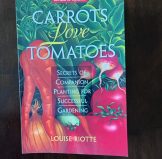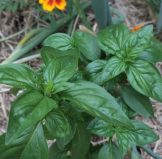 We have recently received a veritable avalanche of excellent well-written, regionally appropriate books about a wide range of gardening approaches, soils and plants, and more are on the way! Hint: If you are a current 2023 Member of Harlequin’s Gardens, you receive 25% off all full-price books, all year!
We have recently received a veritable avalanche of excellent well-written, regionally appropriate books about a wide range of gardening approaches, soils and plants, and more are on the way! Hint: If you are a current 2023 Member of Harlequin’s Gardens, you receive 25% off all full-price books, all year!
 “Carrots Love Tomatoes, Secrets of Companion Planting for SuccessfulGardening“ by Louise Riotte
“Carrots Love Tomatoes, Secrets of Companion Planting for SuccessfulGardening“ by Louise Riotte
The more scientists study plants, the more we learn about plants’ abilities to communicate, protect and support each other. In the past few years we’ve learned that trees feed each other through their root systems, and that plants create sounds in response to environmental conditions. We are more aware than ever of the deep interconnectivity of the community of all life. Gardeners have long observed that some plants, when grown together, impact each other in ways that benefit both. Intentionally growing plants that confer benefits on each other is called ‘Companion Planting.’ One of our favorite books about companion planting is “Carrots Love Tomatoes,” and we’ve seen strong positive results from trying some of the techniques and plant combinations outlined within.
 One simple example you’ve likely heard of is planting your tomato rows along with basil. This book states that “basil helps tomatoes to overcome both insects and disease, also improving growth and flavor.” I did a test at a garden in the Lowry neighborhood of Denver in 2019. We interplanted 3 50-foot rows of Cherokee Purple tomatoes (an heirloom) with basil – one with Thai basil, one with Genovese basil and one with Lemon basil. We planted one basil plant in front of and between each tomato plant (24” between trellised tomato plants). We also planted one row of Cherokee purple without basil. All were on the same irrigation timer.
One simple example you’ve likely heard of is planting your tomato rows along with basil. This book states that “basil helps tomatoes to overcome both insects and disease, also improving growth and flavor.” I did a test at a garden in the Lowry neighborhood of Denver in 2019. We interplanted 3 50-foot rows of Cherokee Purple tomatoes (an heirloom) with basil – one with Thai basil, one with Genovese basil and one with Lemon basil. We planted one basil plant in front of and between each tomato plant (24” between trellised tomato plants). We also planted one row of Cherokee purple without basil. All were on the same irrigation timer.
The Thai and Genovese basil did better than the Lemon basil, which failed mid-midseason after flowering and going to seed (we tried to trim the basil flower stalks every two weeks).
 Results were unequivocal: we had healthier, larger tomato plants with heavier fruit-set in the rows planted with basil. The tomato plants recovered from heat stress more quickly in those rows. We had no insect pests in the rows with basil – we did find several hornworms in the row without the basil. We did not notice any difference in tomato flavor.
Results were unequivocal: we had healthier, larger tomato plants with heavier fruit-set in the rows planted with basil. The tomato plants recovered from heat stress more quickly in those rows. We had no insect pests in the rows with basil – we did find several hornworms in the row without the basil. We did not notice any difference in tomato flavor.
This book includes sections on various plant types (vegetables herbs, wild plants, grasses and grains, fruit, nuts, ornamental trees and shrubs), with sections on garden techniques, soil improvements and pest control. There are several useful garden plans included as well. It is now part of our core planting library!
